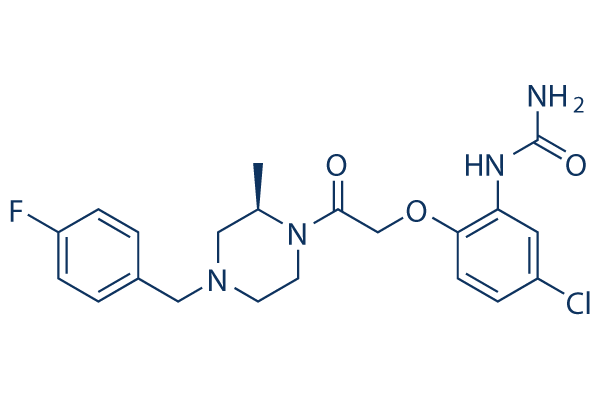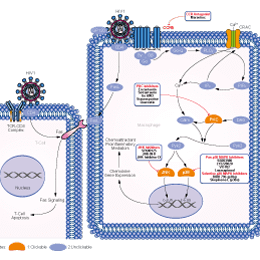
- Bioactive Compounds
- By Signaling Pathways
- PI3K/Akt/mTOR
- Epigenetics
- Methylation
- Immunology & Inflammation
- Protein Tyrosine Kinase
- Angiogenesis
- Apoptosis
- Autophagy
- ER stress & UPR
- JAK/STAT
- MAPK
- Cytoskeletal Signaling
- Cell Cycle
- TGF-beta/Smad
- DNA Damage/DNA Repair
- Compound Libraries
- Popular Compound Libraries
- Customize Library
- Clinical and FDA-approved Related
- Bioactive Compound Libraries
- Inhibitor Related
- Natural Product Related
- Metabolism Related
- Cell Death Related
- By Signaling Pathway
- By Disease
- Anti-infection and Antiviral Related
- Neuronal and Immunology Related
- Fragment and Covalent Related
- FDA-approved Drug Library
- FDA-approved & Passed Phase I Drug Library
- Preclinical/Clinical Compound Library
- Bioactive Compound Library-I
- Bioactive Compound Library-Ⅱ
- Kinase Inhibitor Library
- Express-Pick Library
- Natural Product Library
- Human Endogenous Metabolite Compound Library
- Alkaloid Compound LibraryNew
- Angiogenesis Related compound Library
- Anti-Aging Compound Library
- Anti-alzheimer Disease Compound Library
- Antibiotics compound Library
- Anti-cancer Compound Library
- Anti-cancer Compound Library-Ⅱ
- Anti-cancer Metabolism Compound Library
- Anti-Cardiovascular Disease Compound Library
- Anti-diabetic Compound Library
- Anti-infection Compound Library
- Antioxidant Compound Library
- Anti-parasitic Compound Library
- Antiviral Compound Library
- Apoptosis Compound Library
- Autophagy Compound Library
- Calcium Channel Blocker LibraryNew
- Cambridge Cancer Compound Library
- Carbohydrate Metabolism Compound LibraryNew
- Cell Cycle compound library
- CNS-Penetrant Compound Library
- Covalent Inhibitor Library
- Cytokine Inhibitor LibraryNew
- Cytoskeletal Signaling Pathway Compound Library
- DNA Damage/DNA Repair compound Library
- Drug-like Compound Library
- Endoplasmic Reticulum Stress Compound Library
- Epigenetics Compound Library
- Exosome Secretion Related Compound LibraryNew
- FDA-approved Anticancer Drug LibraryNew
- Ferroptosis Compound Library
- Flavonoid Compound Library
- Fragment Library
- Glutamine Metabolism Compound Library
- Glycolysis Compound Library
- GPCR Compound Library
- Gut Microbial Metabolite Library
- HIF-1 Signaling Pathway Compound Library
- Highly Selective Inhibitor Library
- Histone modification compound library
- HTS Library for Drug Discovery
- Human Hormone Related Compound LibraryNew
- Human Transcription Factor Compound LibraryNew
- Immunology/Inflammation Compound Library
- Inhibitor Library
- Ion Channel Ligand Library
- JAK/STAT compound library
- Lipid Metabolism Compound LibraryNew
- Macrocyclic Compound Library
- MAPK Inhibitor Library
- Medicine Food Homology Compound Library
- Metabolism Compound Library
- Methylation Compound Library
- Mouse Metabolite Compound LibraryNew
- Natural Organic Compound Library
- Neuronal Signaling Compound Library
- NF-κB Signaling Compound Library
- Nucleoside Analogue Library
- Obesity Compound Library
- Oxidative Stress Compound LibraryNew
- Plant Extract Library
- Phenotypic Screening Library
- PI3K/Akt Inhibitor Library
- Protease Inhibitor Library
- Protein-protein Interaction Inhibitor Library
- Pyroptosis Compound Library
- Small Molecule Immuno-Oncology Compound Library
- Mitochondria-Targeted Compound LibraryNew
- Stem Cell Differentiation Compound LibraryNew
- Stem Cell Signaling Compound Library
- Natural Phenol Compound LibraryNew
- Natural Terpenoid Compound LibraryNew
- TGF-beta/Smad compound library
- Traditional Chinese Medicine Library
- Tyrosine Kinase Inhibitor Library
- Ubiquitination Compound Library
-
Cherry Picking
You can personalize your library with chemicals from within Selleck's inventory. Build the right library for your research endeavors by choosing from compounds in all of our available libraries.
Please contact us at [email protected] to customize your library.
You could select:
- Antibodies
- Bioreagents
- qPCR
- 2x SYBR Green qPCR Master Mix
- 2x SYBR Green qPCR Master Mix(Low ROX)
- 2x SYBR Green qPCR Master Mix(High ROX)
- Protein Assay
- Protein A/G Magnetic Beads for IP
- Anti-Flag magnetic beads
- Anti-Flag Affinity Gel
- Anti-Myc magnetic beads
- Anti-HA magnetic beads
- Magnetic Separator
- Poly DYKDDDDK Tag Peptide lyophilized powder
- Protease Inhibitor Cocktail
- Protease Inhibitor Cocktail (EDTA-Free, 100X in DMSO)
- Phosphatase Inhibitor Cocktail (2 Tubes, 100X)
- Cell Biology
- Cell Counting Kit-8 (CCK-8)
- Animal Experiment
- Mouse Direct PCR Kit (For Genotyping)
- New Products
- Contact Us
BX471
Synonyms: ZK811752, BAY 865047, SH T 04268H
BX471 (ZK811752, BAY 865047, SH T 04268H) is a potent nonpeptide CC chemokine receptor-1 (CCR1) antagonist with Ki values of 1 nM and 5.5 nM in both MIP-1α and MCP-3 binding to CCR1-transfected HEK293 cells, respectively.

BX471 Chemical Structure
CAS No. 217645-70-0
Purity & Quality Control
Batch:
Purity:
99.96%
99.96
BX471 Related Products
| Related Targets | CCR1 CCR2 CCR3 CCR4 CCR5 CCR8 CCL | Click to Expand |
|---|---|---|
| Related Products | Cenicriviroc Vicriviroc Malate Adaptavir (DAPTA) ZK756326 2HCl SB-297006 INCB3344 RS102895 Vicriviroc maleate AZD2098 | Click to Expand |
| Related Compound Libraries | FDA-approved Drug Library Natural Product Library Bioactive Compound Library-I GPCR Compound Library | Click to Expand |
Signaling Pathway
Biological Activity
| Description | BX471 (ZK811752, BAY 865047, SH T 04268H) is a potent nonpeptide CC chemokine receptor-1 (CCR1) antagonist with Ki values of 1 nM and 5.5 nM in both MIP-1α and MCP-3 binding to CCR1-transfected HEK293 cells, respectively. |
||||
|---|---|---|---|---|---|
| Targets |
|
| In vitro | ||||
| In vitro | By displacing the ligand binding to CC chemokine receptor-1 (CCR1), BX 471, a potent antagonist, can inhibit the effects medicated by CCR1. In addition, BX-471 exhibits anti-allergic effect by increasing Treg cell population.<sup><a class="sref" href="#s_ref">[1]</a></sup><sup><a class="sref" href="#s_ref">[2]</a></sup> |
|||
|---|---|---|---|---|
| Cell Research | Cell lines | THP-1- or CCR1-transfected HEK293 cells | ||
| Concentrations | 10 µM | |||
| Incubation Time | 24 h | |||
| Method | Binding assays were performed by filtration. Radiolabeled chemokines at a final concentration of approximately 0.1–0.2 nM were used as ligand. HEK293 cells expressing human CCR1 at 8,000 or 300,000 cells per assay point were used as the receptor source. Nonspecific binding was determined in the presence of 100 nM unlabeled chemokine. The binding data were curve-fitted with the computer program IGOR (Wavemetrics) to determine the affinity and number of sites. To demonstrate that CCR1 antagonism by BX 471 was not due to the cellular toxicity of the compound, THP-1- or CCR1-transfected HEK293 cells were treated with BX 471 at concentrations up to 10 µM for 24 h, and cellular toxicity was monitored by measuring WST-1 staining. No significant toxicity was observed. |
|||
| In Vivo | ||
| In vivo | For fasted dogs, the half-life for BX 471 was approximately 3 h, with an oral bioavailability of approximately 60%. In rats of EAE model, CCR1 antagonist, BX 471, dose-dependently decreased the severity of the disease.<sup><a class="sref" href="#s_ref">[1]</a></sup> |
|
|---|---|---|
| Animal Research | Animal Models | Fasted male beagle dogs; Male Lewis Rats of EAE model |
| Dosages | 4 mg/kg (for fasted male beagle dogs); 20 and 50 mg/kg (for Male Lewis Rats) | |
| Administration | p.o. | |
Chemical Information & Solubility
| Molecular Weight | 434.89 | Formula | C21H24ClFN4O3 |
| CAS No. | 217645-70-0 | SDF | -- |
| Smiles | CC1CN(CCN1C(=O)COC2=C(NC(N)=O)C=C(Cl)C=C2)CC3=CC=C(F)C=C3 | ||
| Storage (From the date of receipt) | 3 years -20°C powder | ||
|
In vitro |
DMSO : 87 mg/mL ( (200.05 mM) Moisture-absorbing DMSO reduces solubility. Please use fresh DMSO.) Ethanol : 22 mg/mL Water : Insoluble |
Molecular Weight Calculator |
|
In vivo Add solvents to the product individually and in order. |
In vivo Formulation Calculator |
||||
Preparing Stock Solutions
Molarity Calculator
In vivo Formulation Calculator (Clear solution)
Step 1: Enter information below (Recommended: An additional animal making an allowance for loss during the experiment)
mg/kg
g
μL
Step 2: Enter the in vivo formulation (This is only the calculator, not formulation. Please contact us first if there is no in vivo formulation at the solubility Section.)
% DMSO
%
% Tween 80
% ddH2O
%DMSO
%
Calculation results:
Working concentration: mg/ml;
Method for preparing DMSO master liquid: mg drug pre-dissolved in μL DMSO ( Master liquid concentration mg/mL, Please contact us first if the concentration exceeds the DMSO solubility of the batch of drug. )
Method for preparing in vivo formulation: Take μL DMSO master liquid, next addμL PEG300, mix and clarify, next addμL Tween 80, mix and clarify, next add μL ddH2O, mix and clarify.
Method for preparing in vivo formulation: Take μL DMSO master liquid, next add μL Corn oil, mix and clarify.
Note: 1. Please make sure the liquid is clear before adding the next solvent.
2. Be sure to add the solvent(s) in order. You must ensure that the solution obtained, in the previous addition, is a clear solution before proceeding to add the next solvent. Physical methods such
as vortex, ultrasound or hot water bath can be used to aid dissolving.
Tech Support
Answers to questions you may have can be found in the inhibitor handling instructions. Topics include how to prepare stock solutions, how to store inhibitors, and issues that need special attention for cell-based assays and animal experiments.
Tel: +1-832-582-8158 Ext:3
If you have any other enquiries, please leave a message.
* Indicates a Required Field
Tags: buy BX471 | BX471 supplier | purchase BX471 | BX471 cost | BX471 manufacturer | order BX471 | BX471 distributor







































